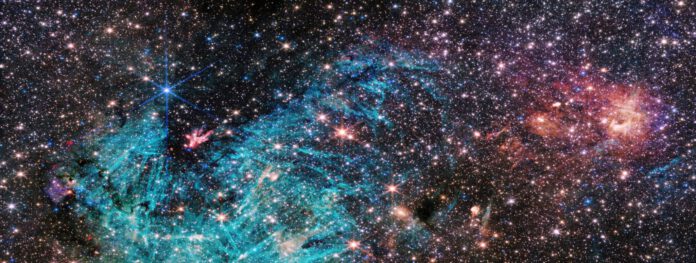
The James Webb Telescope never ceases to amaze. Its latest photo showcases a portion of the galaxy’s heart, captured in unparalleled detail. This star-forming region reveals properties we were previously unaware of, leaving astronomers baffled.
A Dense Region of the Milky Way
The impressive shot features Sagittarius C (Sgr), an incredibly dense area at the galaxy’s center, where countless stars are created. It’s situated around 300 light-years from the supermassive black hole at the heart of the Milky Way, Sagittarius A*. This black hole carries a weight of 4.3 million times that of our sun.
Half-a-million Stars
What is captured in the photo depicts a 50-light-year-wide portion of the galaxy’s core. To provide a sense of scale: one light-year is equivalent to 9.46 trillion kilometers. Earth is roughly 1.3 light-seconds distant from the moon. The photo holds an estimated 500,000 stars! At the center, a cluster of protostars can be observed. These are young stars accumulating mass and radiating a glow akin to a campfire amidst a dark cloud, indicating their emerging from the protective cocoon of the cloud to rapidly match the maturity of surrounding stars.
An Active Region
At the heart of this young star cluster lies a massive protostar, known for some time, carrying over thirty times the mass of our sun. The cloud from which these protostars emerge has such high density that the light of stars positioned behind it can’t even reach the James Webb Telescope. Consequently, it appears there are fewer stars than there truly are. This region is in fact one of the busiest sections of the image. Smaller dark clouds dot the photo, forming voids in a field of stars, where future stars are born.
But there’s more. Webb’s NIRCam (Near-Infrared Camera) also captured a large amount of ionized hydrogen emissions that surround the dark cloud’s lower portion. In the image, it is colored blue-green. Young heavy stars are responsible for ionizing the surrounding gas.
Unexpected Discoveries
Most of what the astronomers can explain ends here, as most fields shown by Webb are a surprise to scientists. For instance, the needle-like structures in the ionized hydrogen call for additional research – they dart chaotically in all directions, a phenomenon never seen in such detail before.
The heart of the galaxy is a mere 25,000 light-years from Earth, close enough for individual stars to be studied using the James Webb Telescope. This provides astronomers with entirely new information about star formation, and how the process may depend on the cosmic environment, especially when compared with other regions in the galaxy. This includes the more massive stars formed at the Milky Way’s center versus stars at the edges of the spiral arms.
NIRCam and MIRI
We owe these extraordinary images largely to the extensive near-infrared range of Webb’s NIRCam instrument. It was specifically designed to effectively capture infrared light. Moreover, Webb also possesses MIRI that observes mid-infrared light. Thanks to these instruments, increasing mysteries of the universe are being unraveled.











